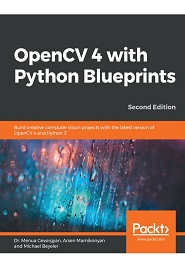
English | 2020 | ISBN: 978-1789801811 | 329 Pages | PDF, EPUB | 231 MB
Practical end-to-end projects covering cutting-edge computer vision concepts such as image processing, machine learning, augmented reality, and artificial neural networks
The goal of this book is to get you hands-on with a wide range of intermediate to advanced projects using the latest version of the framework and language, OpenCV 4 and Python 3.8, instead of only covering the core concepts of OpenCV in theoretical lessons.
This updated second edition will guide you through working on independent hands-on projects that focus on essential OpenCV concepts such as image processing, object detection, image manipulation, object tracking, and 3D scene reconstruction, in addition to statistical learning and neural networks.
You will begin by understanding concepts such as image filters, Kinect depth sensor, and feature matching. You will also learn to reconstruct and visualize a scene in 3D and track visually salient objects. Further on, you will learn to recognize traffic signs and emotions on faces. Towards the end of the book, you will understand how to align images and detect and track objects using neural networks.
By the end of this OpenCV Python book, you will have gained hands-on experience and become proficient at developing your own advanced computer vision applications according to specific business needs.
What you will learn
- Generate real-time visual effects using filters and image manipulation techniques such as dodging and burning
- Recognize hand gestures in real-time and perform hand-shape analysis based on the output of a Microsoft Kinect sensor
- Learn feature extraction and feature matching to track arbitrary objects of interest
- Reconstruct a 3D real-world scene using 2D camera motion and camera reprojection techniques
- Detect faces using a cascade classifier and identify emotions in human faces using multilayer perceptrons
- Understand how to align images with OpenCV
Resolve the captcha to access the links!